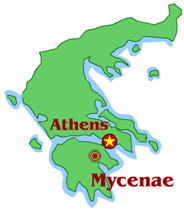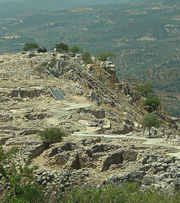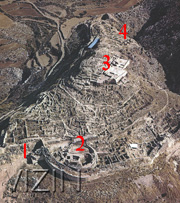Mycenae Greece |
 Location, location, location
Location, location, location
The hill of Mycenae combines a strong geopolitical location that controled access points to and from the Argolid, and a commanding view of the Argive plain to the south below. Located about mid-way between the towns of Corinth and Argos and controlling the natural pass from the Isthmus to the Peloponnese, Mycenae was a royal stronghold that included extensive fortifications, granaries, workrooms, guardrooms, shrines, and a few private dwellings situated around the central palace complex. The palace consisted of a traditional, central megaron meeting hall, throne room and courtyard with adjacent private quarters, storerooms, guard stations, and administrative rooms.
click on the images to enlargeThe site seems to have been first occupied in the Neolithic period (prior to 3000 BCE). Habitation continued throughout the Early and Middle Helladic periods (Early and Middle Bronze Ages; c.3000-1600 BCE) ) and the first palace complex was probably built at the beginning of the Late Helladic period (Late Bronze Age).
Go with the Flow
Initially, the mid 14th c. BCE fortifications probably followed the natural topography of the hilltop, but they were later enlarged to the south and west. In its final design (completed at the beginning of the 13th c. BCE), the citadel added a sally port (or a secondary secure entry or escape doorway near the rear of the citadel) and internal access to an underground water supply. It was at this time that the monumental Lion Gate entrance was constructed. The citadel and palace of Mycenae were destroyed at the end of the Late Helladic IIIB period (c. 1200).During the subsequent Geometric period only a few small houses occupied the summit of the hill. In the Archaic period a temple was built on the summit. The site continued to be inhabited until the end of the 3rd century CE.
Excavations on the citadel began in 1841, with the most well-known undertaken by Heinrich Schliemann and others after 1874. Work on and around the citadel, especially in the newly found lower town, continues today under the direction of Christophilis Maggidis (Dickinson College).
Reference
Page Created: April 30, 2012
Page Updated: April 30, 2012
URL:
Page Author: The Institute for the Visualization of History


